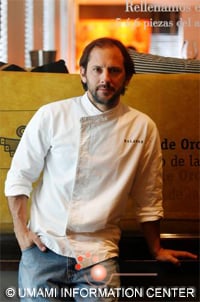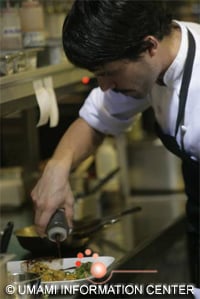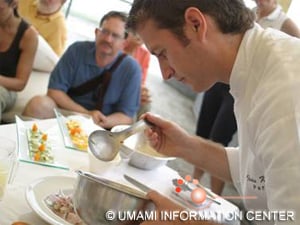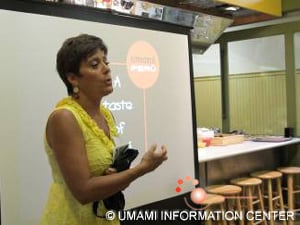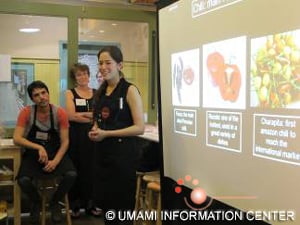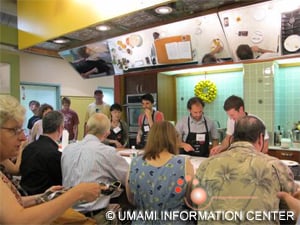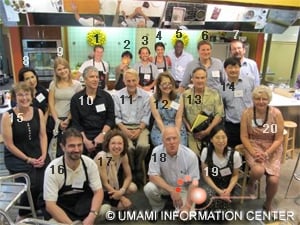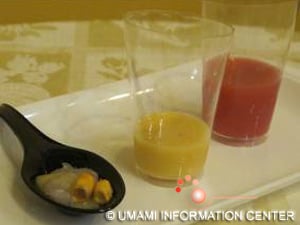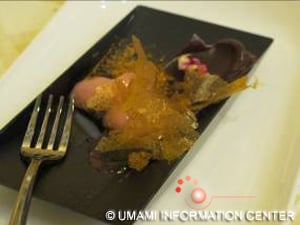Dialogue between Peruvian Chefs and Monell scientists
August 2011
This is the first time that Peruvian chefs meet specialists on taste and smell. The 'Dialogue between Peruvian Chefs and Monell scientists' has gathered three top young Peruvian chefs that are leaders in the Peruvian gastronomy, and fourteen members of the Monell Chemical Senses Center. The encounter begins in The Cucina at the Market inside the historical 'Reading Terminal Market' dedicated to professional cooking demonstrations with products from the market. The owner of the kitchen, Anna Maria Florio, welcomes us warmly before Sandra Montoya's lecture, the PR representative of the Scientific Affairs of Ajinomoto del Peru S.A.
Sandra introduces foods that originated in Peru, such as chili peppers, corn or potatoes, and how biodiversity, different geography, and migrations have contributed to enrich the Peruvian gastronomy. And after that, the three chefs, Chef Pedro Miguel Schiaffino (owner of Malabar Restaurant), Chef Virgilio Martinez (owner of Central Restaurant) and Chef Ivan Kisic (executive chef of LA 73 Restaurant), presented a cooking and tasting demonstration of Peruvian dishes.
1. Chef Ivan Kisic, 2. (UIC) Kumiko Ninomiya, 3. Chef Pedro Schiaffino, 4. Chef Virgilio Martinez, 5. Chef Shola Olunloyo, 6. (Monell) Johan Lundstrum, 7. (Monell) Michael Tordoff, 8. (Monell) Julie Mennella, 9. (Monell visiting scientist) Fernanda Rauber, 10. Paul Breslin, 11. (Monell) Gary Beauchamp, 12. (Monell) Marci Pelchat, 13. Food writer Jack Smith, 14. (Monell) Liquan Huang, 15. (Monell) Leslie Stein, 16. (Monell) Alexander Bachmanov, 17. (UIC) Ana San Gabriel, 18. (Monell) Bruce Bryant, 19. (Monell) Hong Wang, 20. (Monell) Carol Christensen
Monell scientists showed a great interest in the ingredients and cooking techniques used by the Chefs. Some of the foods were from the Amazon, including umami rich foods, for instance the "sachatomate" (tree tomato), a fruit widely consumed in the Peruvian Amazon. A recent analysis of sachatomate at the Japan Food Research Laboratories in Tokyo demonstrated that it is very high in umami substances. Other ingredients that were highlighted include "cecina" (dried salted smoked pork meat) and "paiche" (Amazonian river fish). The chefs themselves suggested including the smoked pork and the river fish in the demonstration because they are convinced that these ingredients are rich in umami.
There were three umami dishes in the Cooking demonstration that stood out: "Peruvian dashi", "Leche de Tigre" and "Five tastes dessert." The Peruvian dashi consists of a soup stock of umami rich Peruvian ingredients: tomato, "sachatomate," "cecina" and "charapita chili." Chef Schiaffino selected these ingredients because of their umami content: he was confident they would result in a tasteful and delicious broth.
The inspiration for this dashi came from an encounter between Schiaffino and the renowned Japanese chef Murata from Kikunoi in Kyoto in June 2010 in a Peruvian Gastronomy and Umami Forum. Chef Murata challenged Pedro to think of a Peruvian dashi according to the Japanese concept of dashi, a very low calorie soup stock made from ingredients rich in umami substances.
The "Leche de tigre" (or Tiger's milk, the spicy juice that comes from the marination of Ceviche, the Peruvian national dish) contains fish and chili as the main umami components. They combine very well with the sour taste of Peruvian lemon, resulting in a truly exquisite starter. Chef Martinez prepared his own version of "Leche de tigre Mar Umami," which he serves at his restaurant. Last but not least, Chef Kisic created the "Five tastes dessert," with one ingredient representing each basic taste; "sachatomate" (tree tomato) was the special ingredient for umami that was intentionally enhanced by the addition of sherry wine.
The second part of the event took place at the Monell Center. Chefs, organizers (Umami committee from Ajinomoto del Peru and Umami Information Center members), and scientists moved to Monell for a round table on the chemical senses, which was accompanied by sensory demos. The chefs had many questions about the chemical senses, such as if there were certain foods that will clot the taste buds. Paul Breslin answered by claiming a lack of evidence. For him it is a wonder that the saliva produced by specialized glands underneath the buds do not clot taste cells.
The chefs also learned from Marcia Pelchat that the intensity with which we perceive a particular taste is relative to the one we have tried immediately before. She also explained that when we can't identify a familiar smell we link it with another one that is associated in our memory to the initial smell. This is why some mistake the smell of crayon with chalk; both are from the classroom. And finally, we also learned that children like very sweet and very salty foods. Julie Mennella let us taste solutions preferred by children so that we could experience how sweet and how salty they were.
At the end of the day, Gary Beauchamp, the director of the Monell Center, gave us a tour during which we all saw how the Center has grown in the last years, including new labs, members, facilities, and scientific equipment, all dedicated solely to researching the mechanisms and functions of chemical sensing.
This fruitful experience would not have been possible without the great support of Leslie Stein, Director of Communications at the Monell Chemical Senses Center.
The co-organizers of this event, Umami Information Center (UIC), Umami Committee in Ajinomoto del Peru S. A., and the Monell Chemical Senses Center, believe that this encounter has been an enriching experience for Peruvian chefs and the rest of participants. Peruvian chefs reinforced their knowledge on umami and presented umami rich Peruvian ingredients. We hope that this 'Dialogue between Peruvian Chefs and Monell scientists' is the first of a series of activities that will bring together science and food. Everyone involved seems to share this idea, as revealed by the following comments:
OPINIONS FROM PARTICIPANTS
Leslie Stein (Communications Director at the Monell Chemical Senses Center): 'I thought that the Umami event featuring your Peruvian chefs and Monell's sensory scientists was extraordinary. It was fascinating to watch the chefs prepare their foods and incorporate so much knowledge at the same time. Many of our scientists have commented on this. The lively conversations over dinner and at the sensory tutorial clearly illustrated how individuals from different cultures and professions can still speak the same language. I personally learned a lot and hope that we have the opportunity to pursue similar collaborations'.
Chef Martinez: 'Participating in this event convinced me that as a cook I stand a great challenge. The fact that cooks and scientists have been able to sit together and discuss a common interest reveals how great and fascinating food science is. I'm now convinced that science is an incentive for chefs' creativity and development. Besides, it is fundamental for achieving a sustainable gastronomy. I'm grateful to all the people who made possible this learning opportunity. I'm happy I got to be a part of it'.
Marcia Pelchat (Associate Member at the Monell Chemical Senses Center): 'Ajinomoto is to be congratulated. I thought that the event was fantastic. It was fun to share sensory demonstrations with such a varied audience and to discuss them from so many different points of view. The high point for me was the cooking demonstrations and your overview of Peruvian foods. I also study food neophobia (why people are reluctant to try new foods). In addition, I had just finished reading a book about the Amazon. So, it was really a thrill to have the opportunity to try such a variety of flavorful, beautifully presented, and extremely exotic dishes. I hope that we have the opportunity to work together again in the future'.
Chef Kisic: 'It was really a unique experience, to be able to exchange our knowledge on Peruvian gastronomy with renowned scientists. In the same way, it was very interesting indeed to learn about how the chemical senses work and how they are related to nutrition and health. It felt like a door opened, showing us limitless possibilities in research and the development of new gastronomic creations to stimulate the senses. I look forward to the opportunity of repeating this experience'.
Paul Breslin: (Member at the Monell Chemical Senses Center and Professor at Rutgers University in the Department of Nutritional Sciences): 'Chef's are essentially food engineers and are also often, of course, artists. The basic sensory science I pursue is not always immediately translated into practice. So it is very interesting and enriching for me to talk with chefs about the implications of basic science for food engineering, as well as what insights chefs have toward basic sensory processes. Chefs often have an inherent scientific wisdom to their gastronomy that is born of years of practice and generations of cultural wisdom, even though they may not know why a process works at a physiological or psychological level. I have always benefited from speaking with engineers who possess practical working knowledge of a system that I study, and these chefs were no exception. I learned a lot and I hope they perhaps learned something from me as well. This give and take is the essence of this type of meeting of minds'.
Chef Schiaffino: 'This event let me learn the theory behind the empirical knowledge I have acquired as a chef. Now I have a better understanding of the results I get when I mix certain ingredients or apply specific cooking techniques. At the same time, I value the opportunity of sharing my knowledge on Peruvian gastronomy with chemical senses' experts. I hope this is not the last event that joins scientists and chefs: I believe we have a lot to learn from each other'.
